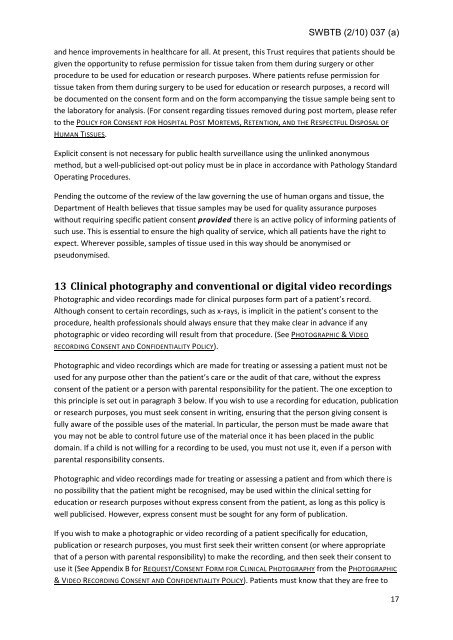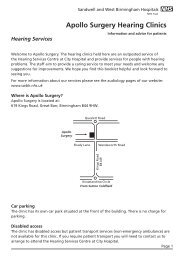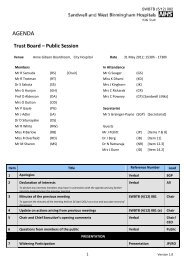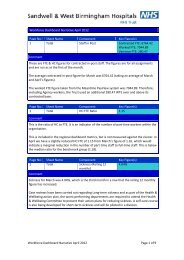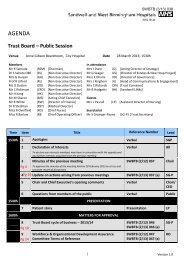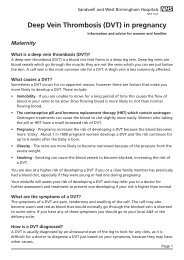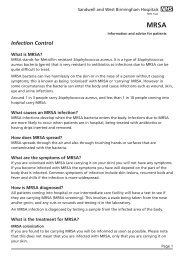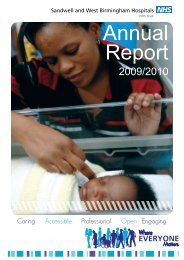Trust Board Febuary 2010 - Sandwell & West Birmingham Hospitals
Trust Board Febuary 2010 - Sandwell & West Birmingham Hospitals
Trust Board Febuary 2010 - Sandwell & West Birmingham Hospitals
You also want an ePaper? Increase the reach of your titles
YUMPU automatically turns print PDFs into web optimized ePapers that Google loves.
SWBTB (2/10) 037 (a)<br />
and hence improvements in healthcare for all. At present, this <strong>Trust</strong> requires that patients should be<br />
given the opportunity to refuse permission for tissue taken from them during surgery or other<br />
procedure to be used for education or research purposes. Where patients refuse permission for<br />
tissue taken from them during surgery to be used for education or research purposes, a record will<br />
be documented on the consent form and on the form accompanying the tissue sample being sent to<br />
the laboratory for analysis. (For consent regarding tissues removed during post mortem, please refer<br />
to the POLICY FOR CONSENT FOR HOSPITAL POST MORTEMS, RETENTION, AND THE RESPECTFUL DISPOSAL OF<br />
HUMAN TISSUES.<br />
Explicit consent is not necessary for public health surveillance using the unlinked anonymous<br />
method, but a well-publicised opt-out policy must be in place in accordance with Pathology Standard<br />
Operating Procedures.<br />
Pending the outcome of the review of the law governing the use of human organs and tissue, the<br />
Department of Health believes that tissue samples may be used for quality assurance purposes<br />
without requiring specific patient consent provided there is an active policy of informing patients of<br />
such use. This is essential to ensure the high quality of service, which all patients have the right to<br />
expect. Wherever possible, samples of tissue used in this way should be anonymised or<br />
pseudonymised.<br />
13 Clinical photography and conventional or digital video recordings<br />
Photographic and video recordings made for clinical purposes form part of a patient’s record.<br />
Although consent to certain recordings, such as x-rays, is implicit in the patient’s consent to the<br />
procedure, health professionals should always ensure that they make clear in advance if any<br />
photographic or video recording will result from that procedure. (See PHOTOGRAPHIC & VIDEO<br />
RECORDING CONSENT AND CONFIDENTIALITY POLICY).<br />
Photographic and video recordings which are made for treating or assessing a patient must not be<br />
used for any purpose other than the patient’s care or the audit of that care, without the express<br />
consent of the patient or a person with parental responsibility for the patient. The one exception to<br />
this principle is set out in paragraph 3 below. If you wish to use a recording for education, publication<br />
or research purposes, you must seek consent in writing, ensuring that the person giving consent is<br />
fully aware of the possible uses of the material. In particular, the person must be made aware that<br />
you may not be able to control future use of the material once it has been placed in the public<br />
domain. If a child is not willing for a recording to be used, you must not use it, even if a person with<br />
parental responsibility consents.<br />
Photographic and video recordings made for treating or assessing a patient and from which there is<br />
no possibility that the patient might be recognised, may be used within the clinical setting for<br />
education or research purposes without express consent from the patient, as long as this policy is<br />
well publicised. However, express consent must be sought for any form of publication.<br />
If you wish to make a photographic or video recording of a patient specifically for education,<br />
publication or research purposes, you must first seek their written consent (or where appropriate<br />
that of a person with parental responsibility) to make the recording, and then seek their consent to<br />
use it (See Appendix B for REQUEST/CONSENT FORM FOR CLINICAL PHOTOGRAPHY from the PHOTOGRAPHIC<br />
& VIDEO RECORDING CONSENT AND CONFIDENTIALITY POLICY). Patients must know that they are free to<br />
17


